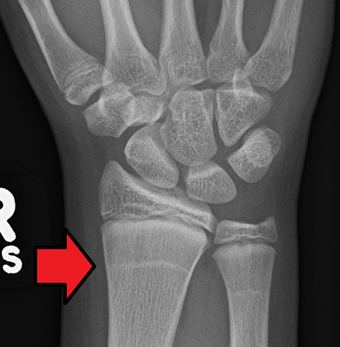Medicine:Harris lines
| Harris lines | |
|---|---|
 | |
| Growth arrest lines in a child with an underlying bone disease |
Harris lines, also known as growth arrest lines, are lines of increased bone density that represent the position of the growth plate at the time of insult to the organism and formed on long bones due to growth arrest. They are only visible by radiograph or in cross-section. The age at which the lines were formed can be estimated from a radiograph. Harris lines are often discussed as a result of juvenile malnutrition, disease or trauma. Other studies suggest a reconsideration of Harris lines as more of a result of normal growth and growth spurts, rather than a pure outcome of nutritional or pathologic stress.
In palaeontology a seasonal pattern of Lines of Arrested Growth (LAGs) is observed in dinosaurs, and has been compared to those observed in amphibians and reptiles, leading to the conclusion that dinosaurs are cold-blooded. More recent research suggests that lags are found in a wide range of mammalian bones.[1][2]
References
- ↑ Brian Switek, Dinosaurs warm up, Nature, 27 June 2012
- ↑ Jason Palmer, Dinosaur cold-blood theory in doubt, BBC News website, 27 June 2012
Further reading
- Tim D. White, 2001. Human Osteology, 2nd Edition. Academic Press, San Diego.
- Chr. Papageorgopoulou, S. K. Suter, F. J. Rühli, F. Siegmund: Harris lines revisited: Prevalence, co-morbidities and possible aetiologies. American Journal of Human Biology 23(3), 2011, S. 381-391. DOI:10.1002/ajhb.21155
- S. Suter, M. Harders, Chr. Papageorgopoulou, G. Kuhn, G. Szekely, F. J. Rühli: Technical note: Standardized and semiautomated Harris lines detection. American Journal of Physical Anthropololy 137, 2008, S. 362–366.
- M. P. Alfonso-Durruty: Experimental assessment of nutrition and bone growth's velocity effects on Harris lines formation. American Journal of Physical Anthropology 145(2), 2011, S. 169-180. DOI:10.1002/ajpa.21480
External links

